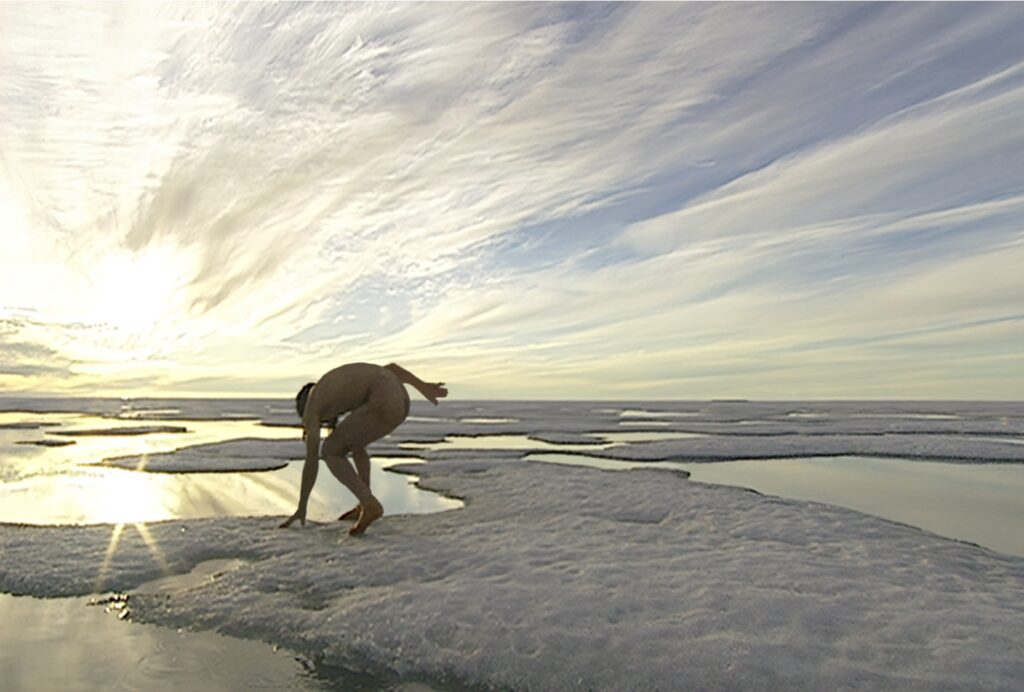IV. THE VULNERABLE BODY

Courtesy of Isuma Distribution International. Image © 2001 Isuma Distribution International.
Where Lucier and Gatten emphasised the material encounter of the moving image with atmospheric conditions, resulting in burnt vidicon tubes and scratched, stained and drowned reels of celluloid, other artists left the image intact and focused on the impact of meteorological forces on the human body. Zacharias Kunuk and Jack Lauder, in separate works, braved the ice, naked as newborns; Joan Jonas fought to stay upright in a howling gale; Smadar Dreyfus recorded acousmatic voices calling through the mist on the Golan Heights and William Raban peered myopically through the fog at South Foreland. Perhaps the most visceral of these works was Bronwyn Platten’s Meeting Nude Woman Walking on Balls (after Hans Baldung Grien, (1514) (2006).
Camera and editing: Alison Main. The artist would like to acknowledge the Kaurna people who are the traditional custodians of this land. She would also like to pay her respects to Elders past and present. Courtesy of the artist.
Where Mary Lucier burned the vidicon tube with the rising sun, Platten subjected the fragile technology of video to the extreme heat of Ochre Point in South Australia – in that temperature it would not have been long before the camera fried. She also exposed to the scorching sun the thin cutaneous membrane that covers her body. In the video, her pale skin submits to the celestial ball of fire that will one day consume the earth she treads so awkwardly, with two spheres strapped to her feet. The absurd, self-imposed handicap to her mobility and her insane noon-day sun bathing stand as a warning to a humanity still blithely depleting the ozone layer. At the same time, her painful progress across Ochre Point expresses both shame and regret that the colour of her skin with its patent unsuitability to the climatic conditions of South Australia associates her with a dark history of British colonialism. The artist has written that as a non-Indigenous artist, she cannot feel grounded, because, she says, she is not “rightful of a place in this country”.[7] This work evades landscape aestheticism and departs radically from the familiar format of a celebrity globetrotter posing in front of a “marvellous” view of some far-flung part of the world. Platten’s naked performance highlights the politics of being there as an outsider filtered through a portrayal of nature as a raw material phenomenon, a physical body interlaced with other, self-propelled earthly entities. By creating what Robert Vischer called “kindred objects”, these works by Welsby, Kunuk and Platten not only assert the indivisibility of all life on earth, but also forge an empathic connectivity between the body of the artist and that of the viewer, connecting across the porous membrane that is the skin of the film.[8] The moving image elicits muscle and nerve memories that enable us to feel the heat of the Australian outback, the frozen tundra of the Inuit homeland like an echo, deep in our own bodies.
[7] Bronwyn Platten (2008), artist’s page, in C. Elwes, E. J. Chua and S. Ball (eds), Figuring Landscapes, exhibition catalogue, London: Catherine Elwes and University of the Arts London, p. 77.
[8] Robert Vischer (1994), ‘On the Optical Sense of Form: A Contribution to Aesthetics’, in H. F. Mallgrave and E. Ikonomou (eds), Empathy, Form, and Space: Problems in German Aesthetics, 1873–1893, Santa Monica: Getty Center for the History of Art and the Humanities, p. 117.